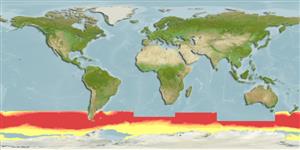>
Perciformes/Notothenioidei (Icefishes) >
Nototheniidae (Cod icefishes) > Nototheniinae
Etymology: Paranotothenia: Greek, para = near + Greek, noton = back + Greek, adverbial particle, then, that denotes distance or removal (Ref. 45335); magellanica: magellanica for the straits of Magellan, the type locality (Ref. 11892).
More on author: Forster.
Environment: milieu / climate zone / depth range / distribution range
Ecologia
marinhas; intervalo de profundidade 0 - 255 m (Ref. 11892), usually 0 - 20 m (Ref. 11892). Temperate; 43°S - 78°S
Southern Ocean: southern tip of South America. Also found in Falkland, South Georgia, South Orkney, South Shetland, Prince Edward, Crozet, Kerguelen, Heard and Macquarie islands, southern New Zealand and associated islands, rarely in the Ross Sea. New Zealand and Argentina (Patagonia) (Ref. 4537)
Tamanho / Peso / Idade
Maturity: Lm ? range ? - ? cm
Max length : 43.0 cm TL macho/indeterminado; (Ref. 124534); peso máx. publicado: 1.5 kg (Ref. 124534)
Descrição suscinta
Chaves de identificação | Morfologia | Morfometria
Espinhos dorsais (total) : 3 - 6; Raios dorsais (total) : 28 - 31; Raios anais : 22 - 25. Greyish olive above, yellowish below. Pug-nosed snout, well developed supraoccipital crest, highly sculptured cranial bones. Short jaw, the maxillary not reaching the orbit, and adults with pelagic coloration as well as large epurals (Ref. 11892). Upper lateral line with 36-48 tubular scales, total number of scales in upper and middle lateral lines 45-57; caudal peduncle longer than deep, 37.0-45.5% HL; preoperculo-mandibular canal not connected with the temporal canal; dorsal surface of head without prominent ridges; pelvic length much shorter than pectorals (Ref. 37311).
Utilized as a food fish.
Ciclo de vida ou comportamento de acasalamento
Maturities | Reprodução | Spawnings | Egg(s) | Fecundities | Larvas
Dewitt, H.H., P.C. Heemstra and O. Gon, 1990. Nototheniidae. p. 279-331. In O. Gon and P.C. Heemstra (eds.) Fishes of the Southern Ocean. J.L.B. Smith Institute of Ichthyology, Grahamstown, South Africa. (Ref. 5179)
Status na Lista Vermelha da UICN (Ref. 130435)
Ameaça para os humanos
Harmless
Uso pelos humanos
Pescarias: espécies comerciais
Ferramentas
Relatórios especiais
Baixar XML
Fontes da internet
Estimates based on models
Preferred temperature (Ref.
123201): 3.4 - 10.8, mean 7.9 °C (based on 130 cells).
Índice de diversidade filogenética (Ref.
82804): PD
50 = 0.7500 [Uniqueness, from 0.5 = low to 2.0 = high].
Bayesian length-weight: a=0.00676 (0.00401 - 0.01141), b=3.23 (3.08 - 3.38), in cm total length, based on LWR estimates for this species & (Sub)family-body (Ref.
93245).
Nível Trófico (Ref.
69278): 3.5 ±0.5 se; based on size and trophs of closest relatives
Generation time: 4.2 ( na - na) years. Estimated as median ln(3)/K based on 1
growth studies.
Resiliência (Ref.
120179): médio(a), tempo mínimo de duplicação da população 1,4 - 4,4 anos (K=0.26; Fec > 10,000).
Fishing Vulnerability (Ref.
59153): Moderate vulnerability (40 of 100).
Nutrients (Ref.
124155): Calcium = 38.5 [21.9, 66.7] mg/100g; Iron = 0.43 [0.26, 0.70] mg/100g; Protein = 18.2 [16.8, 19.5] %; Omega3 = 0.724 [0.440, 1.207] g/100g; Selenium = 11.9 [6.1, 23.1] μg/100g; VitaminA = 16.5 [5.2, 52.5] μg/100g; Zinc = 0.645 [0.461, 0.919] mg/100g (wet weight);
